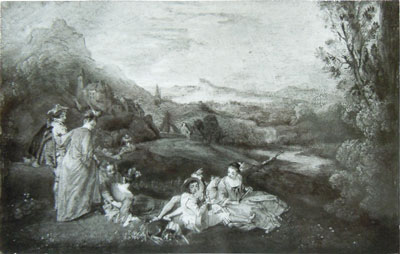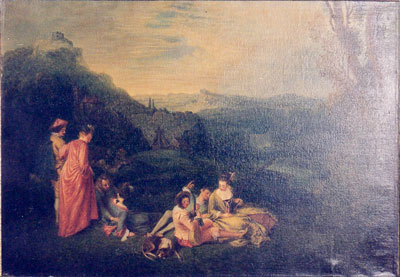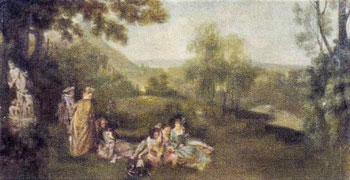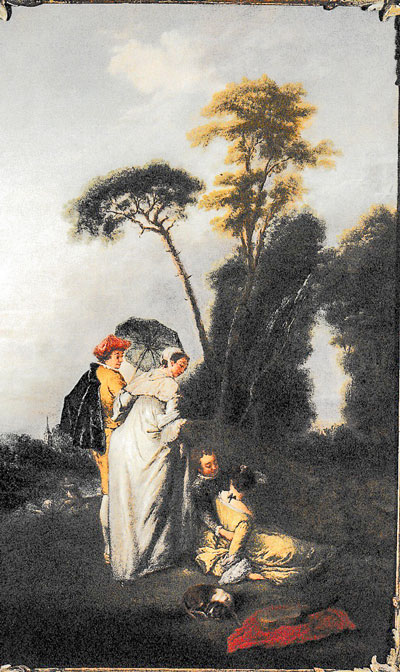
- Home Page
- Accepted
Paintings & Copies - Doubtful
Attributions - Doubtful Textual References
- Alternative
Titles - Collectors &
Museums - Bibliography
- Search Abecedario
- Watteau &
His Circle
L’Amour paisible (copy 1)
Entered March 2015

Whereabouts unknown
Oil on canvas
22 x 26 cm
PROVENANCE
London, collection of George Harland-Peck (c. 1842-1920, manufacturer of varnishes). His sale, London, Christie’s, June 25, 1920, lot 143: “A. WATTEAU. . . . L’AMOUR PAISIBLE A group of ladies and gentlemen in a hilly landscape / 8½ in. by 10¼ in. Exhibited at the Guildhall, 1902.” Sold for £47.5 to Blairman, according to Christies' annotated copy of the sale catalogue, now in the National Art Library, London.
EXHIBITIONS
London, Guildhall, French and English Painters (1902), cat. 122 (as by Watteau, L’Amour paisible, lent by G. Harland-Peck).
Glasgow, Kelvingrove, French and British Artists (1902), cat. 55 (as by Watteau, L'Amour paisible, lent by G. Harland Peck).
SELECT BIBLIOGRAPHY
Zimmerman, Watteau (1912), 142.
Réau, “Watteau” (1928), under cat. 161.
Adhémar, Watteau (1950), under cat. 207.
Potsdam, Meisterwerke aus den Schlössern Friedrichs des Grossen, under cat. 97.
Montagni and Macchia, L’opera completa di Watteau (1968), under cat. 174.
Berlin, Schloss Charlottenburg, Meisterwerke (1962), under cat. 97.
Washington, Paris, and Berlin, Watteau 1684-1721 (1984), under cat. P66.
REMARKS
The painting was evidently attributed to Watteau himself in the nineteenth century and still in 1902 when it was exhibited. Zimmerman, knowing of both the original in Germany and the version in London, recognized that the latter was but a copy. This opinion has been maintained by all subsequent scholars.
The copy is much smaller than the original and while the figures are repeated verbatim, the painting lacks the trees and foliage Watteau included at the right side. The description offered in 1902 when it was exhibited at Guildhall indicates that the woman at the left wore a red dress, her male companion had a rich blue cloak, and the recumbent woman in the foreground had a blue dress—all of which corresponds to Watteau’s color scheme. This suggests that the copy was made directly from the painting.
As is often the case with paintings having an English provenance, Adhémar entered incorrect data. She listed this painting as having been exhibited at the London Guildhall exhibition in 1903 (rather than 1902) under catalogue number 22 (rather than 122). She also claimed that the painting had been shown in an otherwise unidentified Glasgow exhibition in 1902, but it has not been possible to locate any such exhibition.
L’Amour paisible (copy 2)
Entered March 2015; revised February 2022

Whereabouts unknown
Oil on panel
15 x 24 cm
ALTERNATIVE TITLES
Récréation champêtre
Le Repos dans la campagne
PROVENANCE
Paris, collection of Charles Auguste Louis Joseph, duc de Morny (1811-1865). His sale, Paris, May 31ff, 1865, lot 114: “WATTEAU (Antoine)…Récréation champêtre… Des gentilshommes, en compagnie de dames, sont arrêtés sur une éminence d’où l’on aperçoit un paysage montagneux. Les uns sont debout, les autres causent assis sur l’herbe. Un d’eux joue de la guitare. Au loin sur la colline, se voit un vieux castel. Une rivière arrose la vallée; un berger, assis, regarde paître son troupeau. Gravé par Favanne. Bois. Haut. 15 cent.; larg. 24 cent.” Sold to Count P Demidoff for 15.000 FF according to the annotated copy of the catalog in the Rijksbureau voor Kunsthistorische Documentatie.
Paris, collection of Prince Pavel Pavlovich Demidov (1839-1885). His sale, Paris, Hôtel Drouot, February 3, 1868, cat. 41: “VATTEAU (ANTOINE) . . . Récréation champêtre. Des gentilshommes et des dames sont arrêtés sur une éminence au milieu d’un paysage de montagnes. Les uns sont debout, les autres causent assis sur l’herbe; l’un d’eux joue de la guitare. Un chien est couché près de lui. On voit au loin une vallée traversée par une rivière et que domine un vieux château. Ce petit tableau, très précieux, a été gravée par Favanne. H. 15 c. L. 24 c. (Collection de Morny, no 114.).” According to the annotated copy of the catalogue in the Rijksbureau voor Kunsthistorische Documentatie, the painting sold for 13,200FF and was bought by Delaroche.
(?) Paris, Delaroche collection. There was a Parisian sale related to this collection: Hôtel Drouot, March 13-17, 1900, collection of Mlle. *** A copy of the sale catalogue in the Frick Art Reference Library is annotated with the seller’s name “Delaroche.” While the paintings and drawings included works by or after Boucher, Fragonard, Nattier, and others, there is no indication of L’Amour paisible.
Paris, collection of Jorge Ortiz Linares (1894-1980, Bolivian ambassador to France) and his wife Graziella Patiño Ortiz (c. 1895-1980, daughter of tin industrialist Símon Patiño).
Geneva, Switzerland, collection of George Ortiz (1927-2013)
New York, Ortiz collection.
EXHIBITIONS
Paris, Galerie Martinet, Collections d’amateurs (1860), cat. 267 (as by Watteau, L’Amour paisible, lent by M. le comte de Morny).
SELECT BIBLIOGRAPHY
Thoré, “Exposition des tableaux de l’école française” (1860), 271.
Dacier, Vuaflart, and Hérold, Jean de Jullienne et les graveurs (1921-29), under cat. 74.
Réau, “Watteau” (1928), under cat. 161.
Adhémar, Watteau (1950), under cat. 207.
Macchia and Montagni, L’Opera completa di Watteau (1968), under cat. 174.
Washington, Paris, and Berlin, Watteau 1684-1721 (1984), under cat. P66.
Vogtherr, Französische Gemälde (2011), 162.
REMARKS
The de Morny-Demidoff-Delaroche painting was slightly smaller than the one that was in the Harland-Peck collection. The image given above is from an unidentified photo in the Louvre’s Service de documentation. In 1984, Rosenberg postulated that it might be of this version and we have followed him on this, although it now is apparent that several copies of Watteau’s painting are extant.
When Thoré saw this painting in 1860, he complained that due to its poor condition it had been heavily repainted.
L’Amour paisible (copy 3)
Entered March 2015

Whereabouts unknown
Oil on canvas
Measurements unknown
PROVENANCE
Edison, New Jersey, Collection of Professor Joseph Zeidler, c. 1980.
REMARKS
This painting was probably copied directly from the original Watteau canvas. Professor Zeidler was German born and his family reputedly had this painting in its possession for several generations.
L’Amour paisible (copy 4)
Entered March 2015

Whereabouts unknown
Oil on canvas, mounted on panel
62 x 120 cm
ALTERNATIVE TITLES
Festliche Gesellschaft im Freien
PROVENANCE
Zurich, sale, Koller West, September 15-22, 29, 2008, lot 6455: “WATTEAU, ANTOINE . . . Nachfolger / Festliche Gesellschaft im Freien. Öl auf Leinwand auf Holz. Je 62 x 120 cm. CHF 2 000, - 1 300.- / (€1 250. - / 1 800.-) / Siehe Abb.”
REMARKS
Although a relatively accurate copy of L’Amour paisible, the statue of Venus at the left is borrowed from either Watteau’s Plaisir d’amour in Dresden or the Embarquement in Berlin. Also, the proportions have been changed to a more horizontal format so as to include a wider expanse of landscape. The pendant to this work, perfectly matched in terms of proportion and overall composition, is a pastiche of elements from several different but well-known Watteau compositions.
L’Amour paisible (copy 5)
Entered March 2015

Rheinsberg, Schloss
Oil on canvas
147 x 92 cm
ALTERNATIVE TITLES
Stehendes Paar in Rückenansicht und sitzendes Paar in einer Landschaft
SELECT BIBLIOGRAPHY
Vogtherr, Französische Gemälde (2011), 161-62.
REMARKS
This painting copies just the two leftmost couples and sleeping dog from Watteau’s composition but has transposed these elements into a very different landscape and has changed the composition from a horizontal to vertical format. Unlike most copies after Watteau, in this instance we know the author: the French-born court painter to Frederick the Great, Antoine Pesne (1683-1757). Although he could copy directly from the painting, he changed certain features. While keeping the colors Watteau gave the men’s habits, he gave the woman on the ground a yellow gown and the standing woman a white gown. Moreover, he changed the latter costume into one that accorded with contemporary German dress.
L’Amour paisible (copy 6)
Entered July 2021

Whereabouts unknown
Medium unknown
16 x 24.5 cm
PROVENANCE
Paris, collection Madame la Duchesse d’Uzès (née Luynes). Her sale, Paris, Hôtel Drouot
March 18-19, 1942, lot 19: “WATTEAU (d’après) . . . L’Amour paisible. Haut., 0m16; Larg., 0m245.”
REMARKS
We know almost nothing about this painting. We presume that the catalogue was correct in employing the title “L’Amour paisible.”